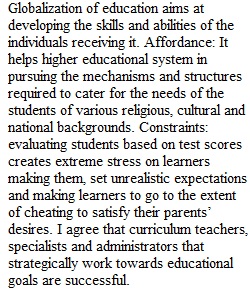


Q Purpose: Graduate students will collaboratively explore, examine, and critically evaluate foundation and current trends and issues in curriculum design and implementation. Clarifying, descriptive, and probing questions related to the required texts and resources provided will be in a reflective, “outline” that will be submitted as a PDF (see instructions below). Set-up: An email will be sent by the instructor approximately three weeks prior to the due date. This email will ask you to access a Google Sheet to sign up for specific dates/times to meet other students to complete this assignment. A Zoom online meeting space link will be shared with the group. Please note that all times listed on the shared Google Sheet are in Central Time Zone (CST). YOU MUST HAVE AT LEAST FOUR (4) INDIVIDUALS IN A GROUP – YOU MUST HAVE NO MORE THAN SIX (6) INDIVIDUALS IN A GROUP. If you prefer to create your groups in advance prior to the instructor’s email, the Google Sheet is located at this link: https://docs.google.com/spreadsheets/d/1Esq-8OmIIXK4QKVNuKVNAbekuMIuXPNCQl0usnTqsNU/edit?usp=sharing PLEASE DO NOT CHANGE THE STRUCTURE OF THE SPREADSHEET. PLEASE DO NOT DELETE INFORMATION FROM OTHER STUDENTS. Instructions: During the collaborative group online meeting, answer the questions related to Modules 4 – 6. a. Before the online meeting, students are responsible for COMPLETING MODULES 4 – 6. b. Reponses should be in a different color than the questions (no answers in black font). c. If the question asks for a [COLLECTIVE RESPONSE], this means the answer should be a descriptive summary of ALL voices in the meeting. d. If the question asks for an [INDIVIDUAL RESPONSE], this means every individual in the group must provide a descriptive response to the question. Ensure that your name is connected to the individual responses (you may color code or use symbols). e. If specific quotes are highlighted or shared in a response, the quote needs to have a citation/reference in APA. f. Once the questions have been answered, every student should receive a copy of the responses, save the document as a PDF, and submit it individually (every student in the group) in Blackboard by the due date. Collaborative Reflection Outline #2: Questions 1. Record the names of the students attending the session. 2. [COLLECTIVE RESPONSE] – How has globalism impacted curriculum (a) efforts in your schools or personal context? What are the affordances and constraints of incorporating globalist efforts in education?
Q 3. [COLLECTIVE RESPONSE] – The authors state that “…successful curriculum specialists, administrators, and teacher-leaders are those who continually learn and follow the regulations” (Glatthorn, 2019, p. 108). Do you agree with this statement? Why4. [COLLECTIVE RESPONSE] – Summarize and describe the differences between the Elementary and Secondary Act (ESEA, 1965), No Child Left Behind (2001), and Every Student Succeeds Act (ESSA, 2015) (introduced on page 109). 5. [INDIVIDUAL RESPONSE] – How has ESSA affected your school context?
Q 6. [INDIVIDUAL RESPONSE] – Choose the court case decision (Tables 4.4 and 4.5 on pages 125-129) that you believe is the most significant and describe why. 7. [COLLECTIVE RESPONSE] – On page 359, the authors suggest that “…an important step for curriculum leaders is to draw valuable lessons from the relationship between current educational research and practice in general.” Relating this idea back to Modules 5 and 6 topic of “learning styles,” should educators base policy and implemented strategies on research and data? Why?
View Related Questions